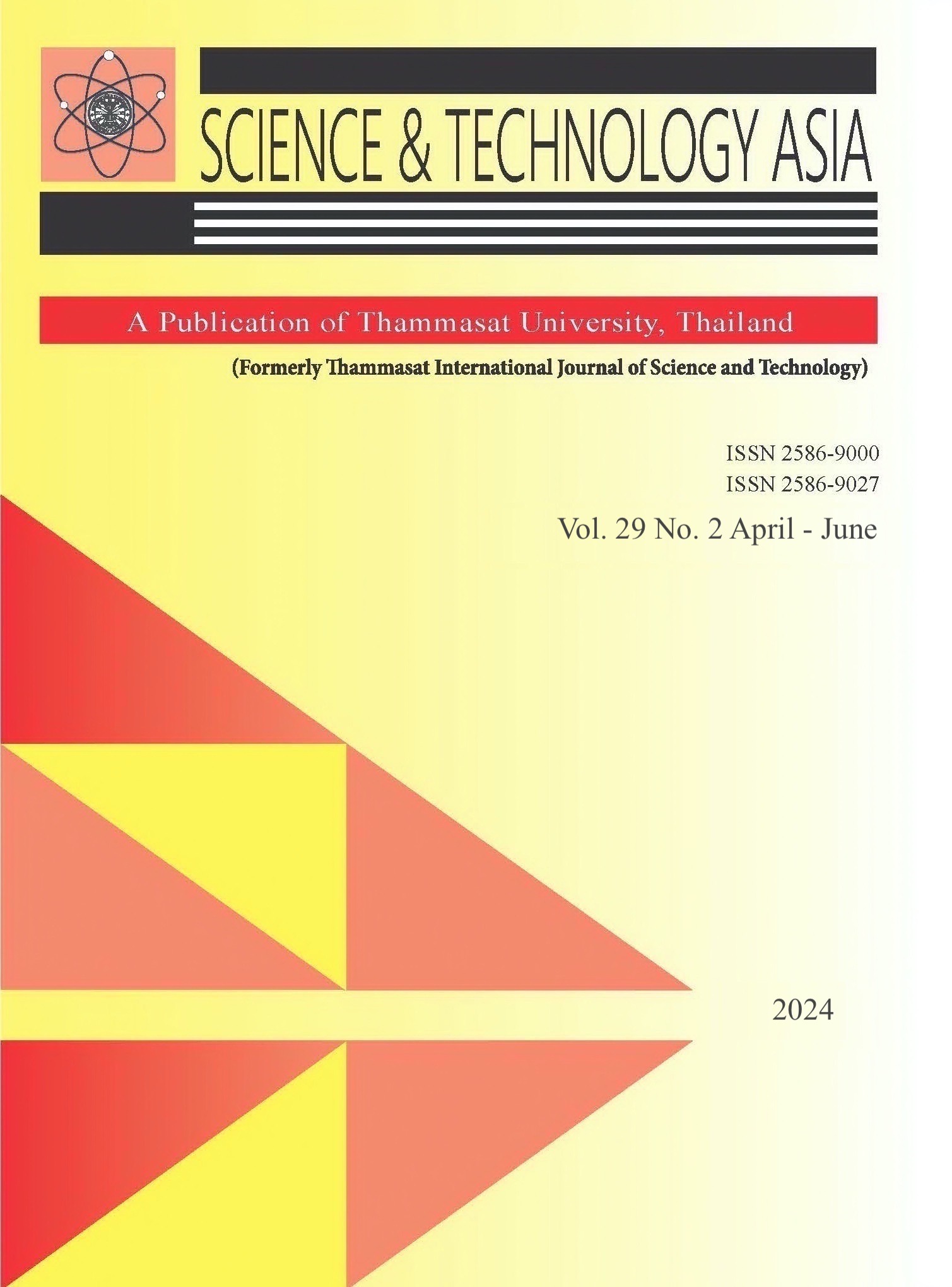Effect of Chemical Fertilizers on the Efficiency of Biochar in Reducing Lead Mobility in Soil
Main Article Content
Abstract
The objective of this research was to investigate the impact of ten different fertilizers on the mobility of lead in soils that had been treated with biochar. The soil used in this study was collected from Chanthaburi Province. To simulate the experimental conditions, this soil was artificially enriched with 550 mg/kg of lead. The synthetic soil was prepared by mixing it with 10% biochar and 0.04% of various chemical fertilizers. To assess the bioavailability of lead in the soil to plants, an extraction process using diethylenetriamine pentaacetate was performed. This allowed researchers to determine how these fertilizers affected the movement and availability of lead in the soil for plant uptake. In the study, it was observed that among the fertilizers tested, urea was the only one that increased the bioavailability of lead in the soil, making it more accessible to plants. Sequential extraction techniques were employed to analyze six different forms of lead in the soil. Interestingly, all fertilizers, except for urea, caused a transformation of lead from less stable forms to more stable forms in the soil. To further investigate the relationship between fertilizer variables and heavy metal uptake, a stepwise linear regression analysis was applied. The results indicated that the mobility of lead in the soil was primarily influenced by the nitrogen content, potassium levels, and sulfate ion concentration in the fertilizers.
Article Details

This work is licensed under a Creative Commons Attribution-NonCommercial-NoDerivatives 4.0 International License.
References
Collin S, Baskar A, Geevarghese DM, Ali MNVS, Bahubali P, Choudhary R, Lvov V, Tovar GI, Senatov F, Koppala S, Swamiappan S. Bioaccumulation of lead (Pb) and its effects in plants: A review. J Hazard Mater Lett 2022;3:100064.
Bellinger DC. Prenatal exposures to environmental chemicals and children’s neurodevelopment: An update. Saf Health Work 2013;4:1-11.
Benzarti S, Mohri S, Ono Y. Plant response to heavy metal toxicity: Comparative study between the hyperaccumulator Thlaspi caerulescens (ecotype Ganges) and nonaccumulator plants: Lettuce, radish, and alfalfa. Environ Toxicol 2008;23;607-16.
Gul S, Whalen JK. Biochemical cycling of nitrogen and phosphorus in biocharamended soils. Soil Biol Biochem 2016;103;1-15.
Jia W, Wang B, Wang C, Sun H. Tourmaline and biochar for the remediation of acid soil polluted with heavy metals. J Environ Chem Eng 2017;5:2107-14.
Bashir S, Hussain Q, Shaaban M, Hu H. Efficiency and surface characterization of different plant derived biochar for cadmium (Cd) mobility, bioaccessibility and bioavailability to Chinese cabbage in highly contaminated soil. Chemosphere 2018;211:632-9.
Ajithram A, Winowlin Jappes JT, Brintha NC. Investigation on utilization of water hyacinth aquatic plants towards various bio products – Survey. Mater Today: Proc 2021;45:2040-5.
Pereira FJ, Castro EM, Oliveira CD, Pires MF, Pereira MP, Ramos SJ, Faquin V. Lead tolerance of water hyacinth (Eichhornia crassipes Mart.–Pontederiaceae) as defined by anatomical and physiological traits. Anais da Academia Brasileira de Ciências 2014;86:1423-33.
Sun L, Niu Z, Sun T. Effects of amendments of N, P, Fe on phytoextraction of Cd, Pb, Cu, and Zn in soil of Zhangshi by mustard, cabbage, and sugar beet. Environ Toxicol 2007;22:565-71.
Land Development Department. A handbook for analyzing samples of soil, water, fertilizer, plants, soil conditioners and analysis for product certification, W.J. Property Co.,Ltd., Bangkok, Thailand; 2014.
US. EPA (1996) Acid digestion of sediments, sludges and soil / SW-846 Method 3050b Available from: https://www.epa.gov/sites/default/files/2015-06/documents/epa-3050b.pdf
Venegas A, Rigol A, Vidal M. Viability of organic wastes and biochars as amendments for the remediation of heavy metalcontaminated soils. Chemosphere 2015;119:190-8.
Lindsay WL, Norvell WA. Development of a DTPA soil test for zinc, iron, manganese, and copper. Soil Sci Soc Am J 1978;42:421- 8.
Initiative IB. Standardized product definition and product testing guidelines for biochar that is used in soil: IBI – std – 2.1, Canandaigua, New York, USA; 2015.
Food and Agriculture Organisation of the United Nation (2017) Agricultural and Veterinary Products (Control of Use) Regulations. Available at: https://www.fao.org/faolex/results/details/en/c/LEX-FAOC180012/
McCauley A, Jones C, Jacobsen J. Soil pH and organic matter. Nutr management module 2009;8:1-12.
Ahmad M, Rajapaksha AU, Lim JE, Zhang M, Bolan N, Mohan D, Vithanage M, Lee SS, Ok YS. Biochar as a sorbent for contaminant management in soil and water: A review. Chemosphere 2014;99:19-33.
Abdel-Fattah TM, Mahmoud ME, Ahmed SB, Huff MD, Lee JW, Kumar S. Biochar from woody biomass for removing metal contaminants and carbon sequestration. J Ind Eng Chem 2015;22:103-9.
Zhao K, Liu X, Xu J, Selim HM. Heavy metal contaminations in a soil–rice system: Identification of spatial dependence in relation to soil properties of paddy fields. J Hazard Mater 2010;181:778-87.
Laing G, Vos R, Vandecasteele B, Lesage E, Tack F, Verloo M. Effect of salinity on heavy metal mobility and availability in intertidal sediments of the Scheldt estuary. Estuar. Coast Shelf Sci 2008;77(4):589-602.
United States Salinity Laboratory Staff. Chloride by titration with silver nitrate. Diagnosis and Improvement of Saline and Alkali Soils, Ag. Handbook 60, USDA, Washington, D.C; 1954.
Hassan MJ, Wang F, Ali S, Zhang G. Toxic effect of cadmium on rice as affected by nitrogen fertilizer form. Plant Soil 2005;277:359-65.
Hiemstra T, Riemsdijk WHV. On the relationship between charge distribution, surface hydration, and the structure of the interface of metal hydroxides. J Colloid Interface Sci 2006;301(1):1-18


